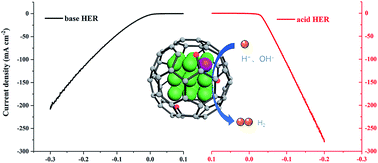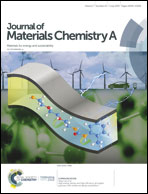O species-decorated graphene shell encapsulating iridium–nickel alloy as an efficient electrocatalyst towards hydrogen evolution reaction†
Abstract
In comparison to other electrocatalysts, graphene possesses two distinguished merits of superior electrical conductivity and anticorrosion performance. However, graphene and graphene oxide are electrocatalytically inert in hydrogen evolution reaction (HER) due to their electronic properties. Herein, for the first time, we report a highly active and stable graphene oxide electrocatalyst for the HER. The graphene oxide-encapsulated IrNi alloy catalyst (IrNi@OC) was prepared via the pyrolysis of Ir-doped Ni-BTC, which exhibited an excellent electrocatalytic activity for the HER, achieving 100 mA cm−2 at a low overpotential of 95 mV in 0.5 M H2SO4 and 10 mA cm−2 at 27 mV in 1 M KOH. Furthermore, these results are superior to those of commercial Pt/C. DFT calculations revealed that electrons were transferred from the IrNi alloy core to the graphene shell, and this process became more facile when graphene was decorated with O species, which tuned the electronic structure of the carbon atoms and made them favorable for the formation of C–H bonds, thereby decreasing the ΔGH* for the HER.



 Please wait while we load your content...
Please wait while we load your content...